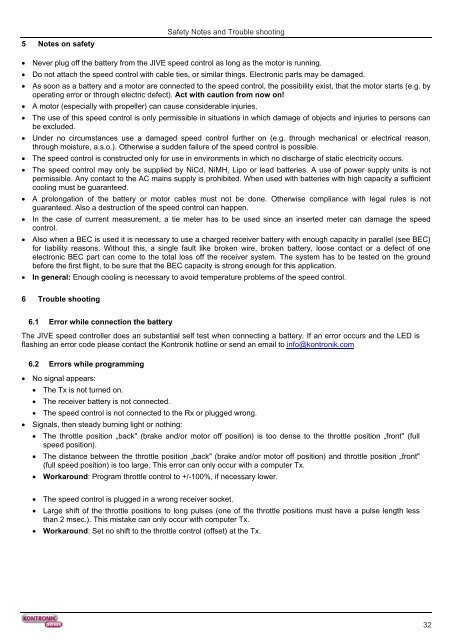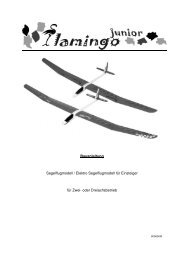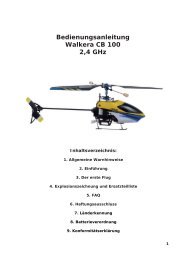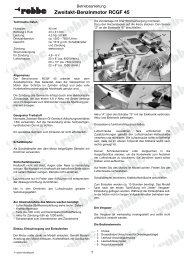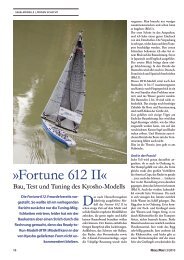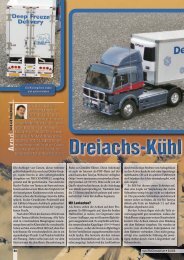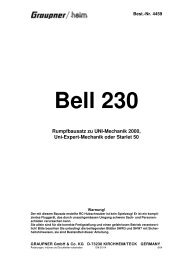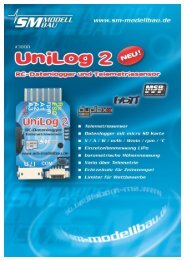Manual - RC-Toy
Manual - RC-Toy
Manual - RC-Toy
Sie wollen auch ein ePaper? Erhöhen Sie die Reichweite Ihrer Titel.
YUMPU macht aus Druck-PDFs automatisch weboptimierte ePaper, die Google liebt.
5 Notes on safety<br />
Safety Notes and Trouble shooting<br />
• Never plug off the battery from the JIVE speed control as long as the motor is running.<br />
• Do not attach the speed control with cable ties, or similar things. Electronic parts may be damaged.<br />
• As soon as a battery and a motor are connected to the speed control, the possibility exist, that the motor starts (e.g. by<br />
operating error or through electric defect). Act with caution from now on!<br />
• A motor (especially with propeller) can cause considerable injuries.<br />
• The use of this speed control is only permissible in situations in which damage of objects and injuries to persons can<br />
be excluded.<br />
• Under no circumstances use a damaged speed control further on (e.g. through mechanical or electrical reason,<br />
through moisture, a.s.o.). Otherwise a sudden failure of the speed control is possible.<br />
• The speed control is constructed only for use in environments in which no discharge of static electricity occurs.<br />
• The speed control may only be supplied by NiCd, NiMH, Lipo or lead batteries. A use of power supply units is not<br />
permissible. Any contact to the AC mains supply is prohibited. When used with batteries with high capacity a sufficient<br />
cooling must be guaranteed.<br />
• A prolongation of the battery or motor cables must not be done. Otherwise compliance with legal rules is not<br />
guaranteed. Also a destruction of the speed control can happen.<br />
• In the case of current measurement, a tie meter has to be used since an inserted meter can damage the speed<br />
control.<br />
• Also when a BEC is used it is necessary to use a charged receiver battery with enough capacity in parallel (see BEC)<br />
for liability reasons. Without this, a single fault like broken wire, broken battery, loose contact or a defect of one<br />
electronic BEC part can come to the total loss off the receiver system. The system has to be tested on the ground<br />
before the first flight, to be sure that the BEC capacity is strong enough for this application.<br />
• In general: Enough cooling is necessary to avoid temperature problems of the speed control.<br />
6 Trouble shooting<br />
6.1 Error while connection the battery<br />
The JIVE speed controller does an substantial self test when connecting a battery. If an error occurs and the LED is<br />
flashing an error code please contact the Kontronik hotline or send an email to info@kontronik.com<br />
6.2 Errors while programming<br />
• No signal appears:<br />
• The Tx is not turned on.<br />
• The receiver battery is not connected.<br />
• The speed control is not connected to the Rx or plugged wrong.<br />
• Signals, then steady burning light or nothing:<br />
• The throttle position „back" (brake and/or motor off position) is too dense to the throttle position „front" (full<br />
speed position).<br />
• The distance between the throttle position „back" (brake and/or motor off position) and throttle position „front"<br />
(full speed position) is too large. This error can only occur with a computer Tx.<br />
• Workaround: Program throttle control to +/-100%, if necessary lower.<br />
• The speed control is plugged in a wrong receiver socket.<br />
• Large shift of the throttle positions to long pulses (one of the throttle positions must have a pulse length less<br />
than 2 msec.). This mistake can only occur with computer Tx.<br />
• Workaround: Set no shift to the throttle control (offset) at the Tx.<br />
32


